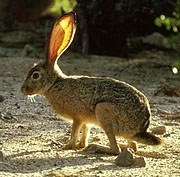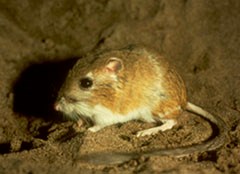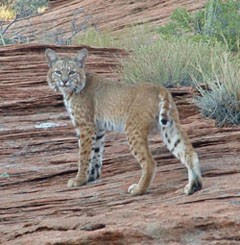
Catching a glimpse of a mouse scurrying to its burrow, stepping around scat, or identifying tracks may be your only experience with the mammals of Glen Canyon National Recreation Area (NRA). Though there are fewer species of mammals in the world than there are birds or reptiles, mammals are diverse and fill many niches. Mammals are warm-blooded, or homeothermic, meaning they have the ability to maintain a constant body temperature, which makes them less dependent on their surroundings and able to live in a wide range of places. Mammals have developed unique adaptations to survive in desert environments like the Colorado Plateau. Hair, unique to this group of life, is generally light in color on desert dwellers. Smaller mammals are more common in a desert environment because of their lower energy requirements and lower rates of heat loss. Bats or rodents require less food and water resources than larger mammals, such as bighorn sheep (Ovis canadensis) or pronghorn (Antilocapra americana), which exert high amounts of energy regulating body temperature. 
NPS Pocket mice and kangaroo rats are common small mammals in Glen Canyon NRA and western North America. These rodents rarely travel far from their complex burrows systems which have separate chambers for nesting, child rearing, sleeping, and food storage. Most rodents remain in these burrows or other shady places during the day to stay cool, becoming active at night. Pocket mice and kangaroo rats block their burrow entrances for safety from predators, which include rattlesnakes, owls, hawks, coyotes, and badgers. Many rodents obtain all of their water from their food, which is an adaptation to the desert environment of several mammals. The primary food source of pocket mice and kangaroo rats is seeds, which they carry back to their burrows in cheek pouches, then neatly store by type. Ord’s kangaroo rat (Dipodomys ordii), common to Glen Canyon NRA, is ecologically important because of their seed caching behavior. The kangaroo rat will husk and cache seeds of Indian ricegrass (Achnatherum hymenoides) and other grasses, sometimes forgetting caches. Kangaroo rats are adept jumpers and are able to change directions while jumping in mid-air, using their tail for balance. Woodrats, or packrats, are known for their storage and garbage structures called middens. Species found in Glen Canyon NRA are the white throated woodrat (Neotoma albigula), bushy-tailed woodrat (N. cinerea), desert woodrat (N. lepida), and Mexican woodrat (N. mexicana). Woodrats prefer to build their middens on rocky slopes in scrublands and pinyon-juniper woodlands. Woodrats will mark their middens and territory with urine which, over time, can crystallize, fossilizing the leaves, seeds, fruit, sticks, pollen, bones, and other items inside. Some middens have been dated to over 50,000 years old. These fossilized garbage piles show a record of the plant and animal communities, or paleocommunities, which once existed in the woodrat’s range. This data can be used to study the changes in plant communities over time and predict future movements. Research derived from woodrat middens on the Colorado Plateau predicts plants will respond individually to global warming in the near future. The deer mouse (Peromyscus maniculatus), also found in the Glen Canyon area, is the primary host for hantavirus. Avoid contact with mice and rats and the saliva, urine, and feces from these rodents to prevent contracting the disease. Bats are the only mammals capable of true flight and are the second largest group of mammals in the world, following rodents. Bats are able to lower their temperature during the day to conserve energy as they roost alone or in colonies in the towering cliffs and canyon walls. Watch and listen for bats in the Glen Canyon area as they emerge at dusk to hunt for insects. The largest bat you are likely to see is the pallid bat (Antrozous pallidus), which is commonly seen at dusk. Some bats may only be seen during migration, such as the big brown bat (Eptesicus fuscus). Bats species in Glen Canyon NRA include little brown myotis (Myotis lucifugus), fringed myotis (Myotis thysanodes), western pipistrelle (Pipistrellus hesperus), and the Brazilian free-tailed bat (Tadarida brasiliensis). Free-tailed bats can reach flight speeds of 60 miles per hour and have special ear adaptations to reduce turbulence. To survive cooler winter temperatures, bats may migrate to a warmer location or lower their body temperature, metabolism, and breathing to conserve energy in a state similar to hibernation called torpor. Disturbing roosting bats or bats in torpor may compromise their energy reserves and survival. Preventing White-nose syndrome in Glen Canyon's bat population isvery important. The black-tailed jackrabbit (Lepus californicus) is characterized by its long, black-tipped ears and long, strong legs. It is common in the Glen Canyon area and can be seen crossing roads or darting between bushes. Jackrabbits get most of their water from vegetation and have large ears to facilitate heat loss. It can reach speeds of up 35 to 40 miles per hour and hop up to 20 feet, eluding predators such as coyotes, foxes, and birds of prey. The black-tailed jackrabbit is the most abundant, widely distributed jackrabbit in North America, and is primarily found in the southwest. However, this it is expanding its northern range north due to a warming climate trend. Larger mammals, like the desert bighorn sheep (Ovis canadensis) must cover more ground to find sufficient food and water, and are seldom seen. Desert bighorn sheep are well-adapted to the desert environment and prefer rocky cliffs away from human activity. Unlike Rocky Mountain bighorn sheep, desert bighorns have smaller bodies, longer legs, and lighter coats. Bighorn sheep are especially vulnerable to diseases carried by domestic sheep and are poor dispersers. Unregulated hunting, habitat destruction, grazing, and disease decimated or eliminated bighorn sheep populations across the west in the 1800s. The bighorn sheep of Glen Canyon NRA have been reestablished from herds in the Escalante and Canyonlands areas. Though there is no historical evidence of river otters in the Escalante area, the Sonoran river otter (Lutra canadensis) is presumed to have been in the area and is probably extinct. Northern river otters, a different subspecies, were introduced to the Escalante River in Grand Staircase Escalante National Monument to reestablish an otter population. These introduced Northern river otters have reached Lake Powell. 
Gerry Nealon Predators in the area include bobcats (Felis rufus), mountain lions (F. concolor), and coyotes (Canis latrans). These mammals avoid humans, but their tracks and scat show their presence in the area. Prey includes rodents, birds, lizards, domesticated animals, and other large mammals like mule deer (Odocoileus hemionus). Black bear (Ursus americanus) are very rare. There is one record of a male elk at Lee’s Ferry, which must have come down the Paria River. The gray wolf (C. lupus) and grizzly bear (U. arctos) were historically found in the Glen Canyon area. Following Anglo-American settlement, native prey was over-hunted and these predators began preying on livestock. This eventually led to the extirpation of the gray wolf and grizzly bear. Bison (Bison bison) were transplanted in 1941 from Yellowstone National Park to the Henry Mountains northwest of Glen Canyon NRA. They roam freely and are one of the only remaining genetically pure bison herds. Though normally found on the Henry Mountains, some bison may occur in the Little Rockies area and Thompson Mesa near Halls Creek in the winter. Native species, like the bighorn sheep, kangaroo rat, and coyote, are integral parts of the Colorado Plateau ecosystem. Protection of native populations can preserve natural ecosystem functions and prevent endangerment and extinction of unique species. Increased scientific research on the mammal populations of the Colorado Plateau will reveal more about the local animal communities and the significance of these species. Published 8/07 |
Last updated: January 9, 2024
